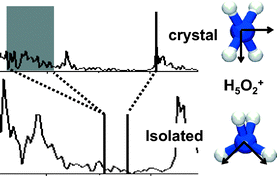Environmental effects on vibrational proton dynamics in H5O2+: DFT study on crystalline H5O2+ClO4−
Abstract
The structure as well as

* Corresponding authors
a Institut für Chemie, Humboldt-Universität zu Berlin, Unter den Linden 6, Berlin, Germany
The structure as well as

 Please wait while we load your content...
Something went wrong. Try again?
Please wait while we load your content...
Something went wrong. Try again?
M. V. Vener and J. Sauer, Phys. Chem. Chem. Phys., 2005, 7, 258 DOI: 10.1039/B412795A
To request permission to reproduce material from this article, please go to the Copyright Clearance Center request page.
If you are an author contributing to an RSC publication, you do not need to request permission provided correct acknowledgement is given.
If you are the author of this article, you do not need to request permission to reproduce figures and diagrams provided correct acknowledgement is given. If you want to reproduce the whole article in a third-party publication (excluding your thesis/dissertation for which permission is not required) please go to the Copyright Clearance Center request page.
Read more about how to correctly acknowledge RSC content.
 Fetching data from CrossRef.
Fetching data from CrossRef.
This may take some time to load.
Loading related content
